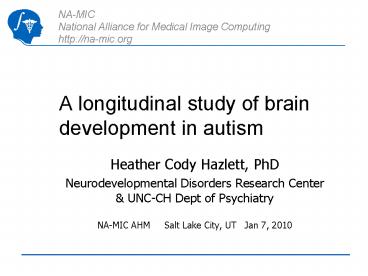A longitudinal study of brain development in autism - PowerPoint PPT Presentation
1 / 18
Title:
A longitudinal study of brain development in autism
Description:
Surfaced based morphetry shows decreased CT in school- age ASD (Chen ... A Slicer3 high-level module for individual cortical thickness analysis has been ... – PowerPoint PPT presentation
Number of Views:165
Avg rating:3.0/5.0
Title: A longitudinal study of brain development in autism
1
A longitudinal study of brain development in
autism
- Heather Cody Hazlett, PhD
- Neurodevelopmental Disorders Research Center
- UNC-CH Dept of Psychiatry
- NA-MIC AHM Salt Lake City, UT Jan 7, 2010
2
UNC DBP-2 Team
- DBP-2
- PI Heather Cody Hazlett
- Co-PI Joseph Piven
- CS Programmers Clement Vachet, Cedric Matthieu
- Core 1 Martin Styner, UNC Chapel Hill
- UNC Algorithm Ipek Oguz, Nicolas Augier, Marcel
Prastawa, Marc Niethammer, Clement Vachet, Cedric
Mathieu - Core 2 Jim Miller, GE Research
3
Project Cortical thickness analysis of
pediatric brain
- Project Goals
- Individual and group analysis of regional and
local cortical thickness - Creation of an end-to-end application within
Slicer3 - Apply pipeline to our large pediatric dataset of
children with ASD
4
Autism
- Neurodevelopmental disorder of language, social
communication, and stereotyped behavior - Neuroimaging findings (volumetric studies)
- Brain enlargement
- Gray white matter enlargement
- Enlargement is present early
5
Cortical thickness in ASD
- Surfaced based morphetry shows decreased CT in
school- age ASD (Chen et al 2009) - Regional CT decreased in adults with ASD
(Raznahan et al 2009) - VBM and CT increased in brain regions
associated with autism in young adults with ASD
(Hyde et al 2009) - Decreased volume and CT over time in small
sample of school-aged males with ASD (Hardan et
al 2009)
6
Regional cortical thickness
7
Regional Cortical Thickness - Pipeline Overview
A Slicer3 high-level module for individual
cortical thickness analysis has been developed
ARCTIC (Automatic Regional Cortical ThICkness)
Input raw data (T1-weighted, T2-weighted,
PD-weighted images) Three steps in the
pipeline 1. Tissue segmentation 2. Regional
atlas deformable registration 3. Cortical
Thickness
8
Sample Characteristics Time 1 Age (yrs) Time
2 Age (yrs) Male Group N M (SD) N M (SD) at
Time 1 ASD 59 2.7 (.32) 38 5.04
(.41) 86 Controls 38 2.6 (.52) 21 4.69
(.46) 74
Percent male at Time 2 ASD 89, Controls 71
9
(No Transcript)
10
(No Transcript)
11
(No Transcript)
12
(No Transcript)
13
atlas deformable registration
Skull stripped data
Parcellation map
14
plt.0001 plt.05
15
Next steps
- Complete pipeline for local cortical thickness
- Explore cortical thickness in relation to
clinical and genetic data
16
Local Cortical Thickness - Pipeline Overview
Eleven steps in the pipeline
1. Tissue segmentation 2. Atlas-based ROI
segmentation 3. White matter map creation 4.
White matter map post-processing 5. Genus zero
white matter map image surface
creation 6. Gray matter map creation
7. White matter surface inflation 8. Cortical
correspondence 9. Label map creation 10.
Cortical thickness 11. Group statistical
analysis
17
Other collaborations
- Caudate shape
- Ross Whitaker, Josh Cates, Martin Styner, Michele
Poe - Grant submission
- New statistical models for investigating
subcortical shapes (S Marron, UNC stats)
18
Contributors
- Joe Piven, MD
- Guido Gerig, PhD
- Martin Styner, PhD
- Clement Vachet, MS
- Cedric Matthieu, BA
- Rachel Smith, BA
- Mike Graves, MChE
- Sarah Peterson, BA
- Matt Mosconi, PhD
NA-MIC Team Jim Miller Ipek Oguz Nicolas
Augier Marc Niethammer Brad Davis
Parent grant funded by the National Institutes of
Health































